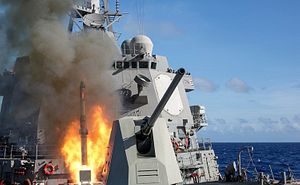China and Russia, along with a number of other competitors, are “focused on taking the lead” in the maritime domain and will continue to challenge U.S. naval superiority, the Chief of Naval Operations, Admiral John Richardson, writes in a recently released U.S. Navy strategy document.
The U.S. Navy “must pick up the pace and deny” foreign competitors their objectives, even though the admiral cautions that the “margins of victory are razor thin – but decisive.” The January 2016 document entitled “A Design for Maintaining Maritime Superiority” lays out a design based on four lines of effort—“warfighting, learning faster, strengthening our Navy team, and building partnerships”—for the U.S. Navy to be a more effective fighting force in the 21st century.
More interestingly, however, is the characterization of the strategic environment the U.S. Navy finds itself in, according to the highest ranking naval officer of the United States. While Richardson notes the influence of the global information system, the increasing rate of technological creation and adoption, and increased ocean traffic on U.S. Navy operations, the document becomes more concrete when discussing the threats posed by nation states–particularly China and Russia.
“Russia and China both have advanced their military capabilities to act as global powers,” he notes. “Their goals are backed by a growing arsenal of high-end warfighting capabilities, many of which are focused specifically on our vulnerabilities and are increasingly designed from the ground up to leverage the maritime, technological and information systems.”
“They continue to develop and field information-enabled weapons, both kinetic and non-kinetic, with increasing range, precision and destructive capacity.” One response to this has been the re-organization and re-equipping of the U.S. Navy’s surface fleet by grouping ships into small surface action groups and increasing the number of anti-ship weapons on more platforms, a tactical shift the Navy calls “distributed lethality.”
Additionally, the admiral notes:
Both China and Russia are also engaging in coercion and competition below the traditional thresholds of high-end conflict, but nonetheless exploit the weakness of accepted norms in space, cyber and the electromagnetic spectrum. The Russian Navy is operating with a frequency and in areas not seen for almost two decades, and the Chinese PLA(N) is extending its reach around the world.
While also focusing on North Korea and Iran, as well as non-state actors, the admiral clearly appears to be concerned most over the rise of Chinese and Russian naval power. He also notes given budgetary constraints “we will not be able to ‘buy’ our way out of the challenges that we face.”

































